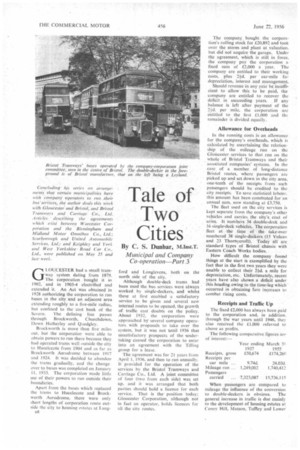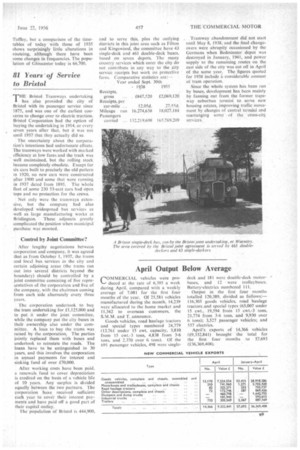Tale of Two Cities
Page 42

Page 43

If you've noticed an error in this article please click here to report it so we can fix it.
By C. S. Dunbar, M.Inst.T.
Municipal and Company Co-operation—Part.3 Concludinghis series on arrangements that certain municipalities have with company operators to run .their bus services, the author deals this week with Gloucester and Bristol, and Bristol Tramways and Carriage Co., Ltd. .4 runes describing the agreements which exist between Worcester Corporation and the Birmingham and Midland Motor Omnibus Co., Ltd.: Scarborough and United Automobile Services, Ltd.; and Keighley and York and West YorkshireRoad Car Co.. Lid., were published on May 25 and last. week.
GLOU.CESTER had a small tramway system dating from 1879. The corporation bought it in 1902, " and in 1903-4 electrified and extended it. An Act was obtained in 1928 authorizing the corporation to run buses in the city and an adjacent area extending roughly to a five-mile radius, but confined to the "east bank of the Severn. The defining line passes through Brockworth, ChurchdoWn, Down Hatherley and Quedgley.
Brock worth is more than five miles out, but the corporation were able to obtain powers to run there because they had operated trams well outside the city to Hucclecote from 1904 and as far as Brockworth Aerodrome between 1917 and 1924. It was decided to abandon the trams gradually, and the change over to buses was completed on January 11, 1933. The corporation made little use of their powers to run outside their boundaries.
Apart from the buses which replaced the trams to Hucclecote and Brockworth Aerodrome, there were only short lengths of corporation route outside the city to housing estates at Lang 88
ford and Longlevens, both on the north side of the city.
Although double-deck trams had been used the bus services were always worked by single-deckers, and whilst these at first enabled a satisfactory service to be given and several new internal routes to be opened, the growth of traffic cast doubts on the policy. About 1932, the corporation were approached by several company operators with proposals to take over the system, but it was not Until l936 that unsatisfactory prospects of the -undertaking caused the corporation to enter into an agreement . with the Tilling group for a lease.
The agreement was for 21 years from April I. 1936, and then to run annually. It provided for the operation of the services by the Bristol Tramways and Carriage Co.. Ltd. A joint committee of four (two from each side) was set up. and it was arranged that both parties should hold a licence for each service. That is the position today; Gloucester Corporation, although not in fact an operator, holds licences for all the city routes. The company. bought the corporation's rolling stock for £20,892 and took over the stores and plant at valuation. but did not acquire the garage. Under the agreement, which is still in force. the company pay the corporation a fixed sum of £2,000 a year. The company are entitled to their working costs. plus 21d. per car-mile for depreciation, interest and management.
Should revenue in any year be insufficient to allow this to be paid, the company are entitled to recover the deficit in succeeding years. If any balance is left after payment of the 24d. per mile, the corporation are entitled to the first £1,000 and the remainder is divided equally.
Allowance for Overheads
In the running costs is-an, allowance for the company's overheads, which is calculated by ascertaining the relationship of the mileage run on the Gloucester services to that run on the whole of Bristol Tramways and their associated companies' systems. In the case of a number of long-distance Bristol routes, where passengers are picked up and set down in the city area. one-tenth of the receipts from such passengers should be credited to the city receipts. To save statistical labour. this amount has been commuted for an annual sum. now standing at 13,750.
The fleet used on the city services is kept separate from the company's other vehicles and carries the city's, coat of arms. It numbers 34 double-deck and 16 single-deck vehicles. The corporation fleet at the time of the take-over numbered 38 single-deckers (15 Vulcan and 23 Thomycroft). Today all are standard types of Bristol chassis with Eastern Coach Works bodies.
How difficult the company found things at the start is exemplified by the fact that in the first two years they were unable to collect their 24-d. a mile for depreciation, etc. Unfortunately, recent years have also shown a deficit under this heading owing to the time-lag which occurred in obtaining fare increases to combat rising costs.
Receipts and Traffic Up
The fixed £2,000 has always been paid to the corporation and, in addition. through the war years until 1946, they also received the £1,000 referred to above as profits.
The following comparative figures are of interest:— When passengers are compared to mileage the influence of the conversion to double-deckers is obvious. The general increase in traffic is due mainly to the development of housing estates at Coney Hill, Matson, Tuffiey and Lower Talley, but a comparison of the timetables of today with those of 1935 shows surprisingly little alterations in routeing, although there have been some changes in frequencies. The population of Gloucester today is 66,700.
81 Years of Service to Bristol
THE Bristol Tramways undertaking has also provided the city of Bristol with its passenger service since 1875, and was one of the earliest concerns to change over to electric traction. Bristol Corporation had the option of buying the undertaking in 1914, or every seven years after that. but it was not until 1937 that they actually did so.
The uncertainty about the corporation's intentions had unfortunate effects. The tramways were worked with marked efficiency at low fares and the track was well maintained, but the rolling stock became completely obsolete. Except for six cars built to precisely the old pattern in 1920, no new cars were constructed after .1900 and some that were running in 1937 dated from 1895. The whole fleet of .some 230 53-scat cars had open tops and no protection for the crews.
Not only were the tramways extensive, but the company had also developed widespread bus services as well as large manufacturing works at Brislington. These adjuncts greatly complicated the position when mMlielpal purchase was mooted.
Control by Joint Committee?
After lengthy negotiations between corporation and company, it was agreed that as from October I, 1937, the trams and local bus services in the city and certain adjoining areas (the trains ran out into several districts beyond the boundary) should be controlled by a joint committee consisting of five representatives of the corporation and five of the company, with the chairman coming from each side alternately every three years.
The corporation undertook to buy the tram undertaking for £1,125,000 and to put it under the joint committee, while the company put the city buses in their ownership also under the committee. A loan to buy the trams was raised by the corporation; The parties jointly replaced them with buses and undertook to reinstate the roads. The loans have to be extinguished in 30 years, and this involves the corporation in annual payments for interest and sinking fund of over 170,000.
After working costs have been paid, a renewals, fund to cover depreciation is credited on the basis of a vehicle life of 10 years. Any surplus is divided equally between the two partners. The corporation have received sufficient each year to cover their interest payments and have paid off a good part of their capital outlay.
The population of Bristol is 444,900. and to serve this, plus the outlying districts in this joint area such s Filton and Kingswood, the committee have 43 single-deck and 461 double-deck buses, based on seven depots. The many country services which enter the city do not contribute in any way to the pity service receipts but work on protective fares. Comparative statistics are: Tramway abandonment did not start until May 8, 1938, and the final changeovers were abruptly occasioned by the Germans when Bedminster depot was destroyed in January, 1941, and power supply to the remaining routes on the east side of the city was cut off in April of the same year. The figures quoted for 1938 include a considerable amount of tram operation.
Since the whole system has been run by buses, development has been mainly by fanning out from the former tramway suburban termini to serve new housing estates, improving traffic movement by changes of central termini and rearranging some of the cross-city services.




































































































